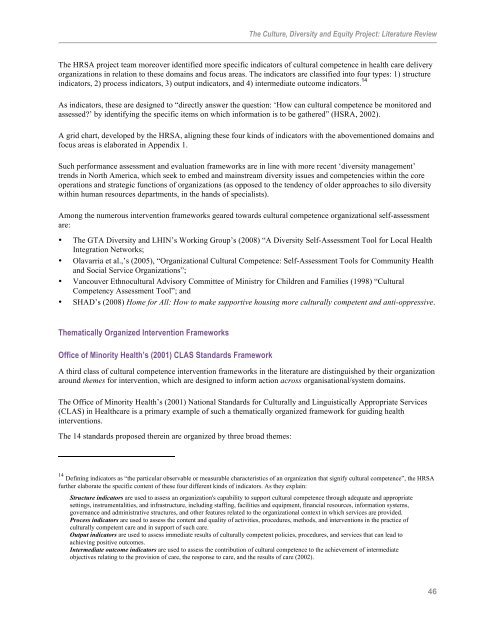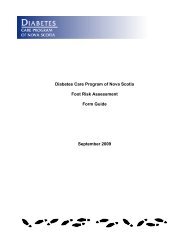CDE Appendix 1 Literature Review - Central East Local Health ...
CDE Appendix 1 Literature Review - Central East Local Health ...
CDE Appendix 1 Literature Review - Central East Local Health ...
You also want an ePaper? Increase the reach of your titles
YUMPU automatically turns print PDFs into web optimized ePapers that Google loves.
The Culture, Diversity and Equity Project: <strong>Literature</strong> <strong>Review</strong><br />
The HRSA project team moreover identified more specific indicators of cultural competence in health care delivery<br />
organizations in relation to these domains and focus areas. The indicators are classified into four types: 1) structure<br />
indicators, 2) process indicators, 3) output indicators, and 4) intermediate outcome indicators. 14<br />
As indicators, these are designed to “directly answer the question: ‘How can cultural competence be monitored and<br />
assessed?’ by identifying the specific items on which information is to be gathered” (HSRA, 2002).<br />
A grid chart, developed by the HRSA, aligning these four kinds of indicators with the abovementioned domains and<br />
focus areas is elaborated in <strong>Appendix</strong> 1.<br />
Such performance assessment and evaluation frameworks are in line with more recent ‘diversity management’<br />
trends in North America, which seek to embed and mainstream diversity issues and competencies within the core<br />
operations and strategic functions of organizations (as opposed to the tendency of older approaches to silo diversity<br />
within human resources departments, in the hands of specialists).<br />
Among the numerous intervention frameworks geared towards cultural competence organizational self-assessment<br />
are:<br />
• The GTA Diversity and LHIN’s Working Group’s (2008) “A Diversity Self-Assessment Tool for <strong>Local</strong> <strong>Health</strong><br />
Integration Networks;<br />
• Olavarria et al.,’s (2005), “Organizational Cultural Competence: Self-Assessment Tools for Community <strong>Health</strong><br />
and Social Service Organizations”;<br />
• Vancouver Ethnocultural Advisory Committee of Ministry for Children and Families (1998) “Cultural<br />
Competency Assessment Tool”; and<br />
• SHAD’s (2008) Home for All: How to make supportive housing more culturally competent and anti-oppressive.<br />
Thematically Organized Intervention Frameworks<br />
Office of Minority <strong>Health</strong>’s (2001) CLAS Standards Framework<br />
A third class of cultural competence intervention frameworks in the literature are distinguished by their organization<br />
around themes for intervention, which are designed to inform action across organisational/system domains.<br />
The Office of Minority <strong>Health</strong>’s (2001) National Standards for Culturally and Linguistically Appropriate Services<br />
(CLAS) in <strong>Health</strong>care is a primary example of such a thematically organized framework for guiding health<br />
interventions.<br />
The 14 standards proposed therein are organized by three broad themes:<br />
14 Defining indicators as “the particular observable or measurable characteristics of an organization that signify cultural competence”, the HRSA<br />
further elaborate the specific content of these four different kinds of indicators. As they explain:<br />
Structure indicators are used to assess an organization's capability to support cultural competence through adequate and appropriate<br />
settings, instrumentalities, and infrastructure, including staffing, facilities and equipment, financial resources, information systems,<br />
governance and administrative structures, and other features related to the organizational context in which services are provided.<br />
Process indicators are used to assess the content and quality of activities, procedures, methods, and interventions in the practice of<br />
culturally competent care and in support of such care.<br />
Output indicators are used to assess immediate results of culturally competent policies, procedures, and services that can lead to<br />
achieving positive outcomes.<br />
Intermediate outcome indicators are used to assess the contribution of cultural competence to the achievement of intermediate<br />
objectives relating to the provision of care, the response to care, and the results of care (2002).<br />
46

















